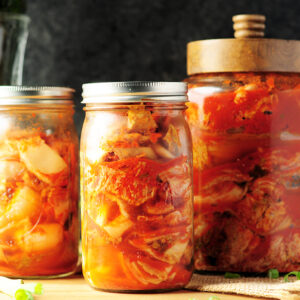Traditional Kimchi Recipe
A step-by-step guide to show you how to make traditional Korean kimchi at home in just 7 steps.
- Prep Time: 2 hours 20 minutes
- Cook Time: 10 minutes
- Total Time: 2 hours 30 minutes
- Yield: 8 Pounds Kimchi
- Category: Appetizer, Gluten Free
- Cuisine: Korean
Ingredients
Units
Scale
For salting cabbage:
- 4 heads of medium napa cabbage (about 6 pounds)
- 1/2 - 1 cup Kosher salt
For making the kimchi paste base:
- 2 cups water
- 2 tablespoons sweet rice flour (glutinous rice flour)
- 2 tablespoons brown sugar
Vegetables:
- 2 cups daikon, cut into matchsticks
- 1 cup carrot, cut into matchsticks
- 10 stems green onions, chopped
- 24 medium garlic cloves (about 1/2 cup minced garlic)
- 1 1-inch chunk ginger (about 2 teaspoons minced ginger)
- 1 medium white onion
Seasonings and spices:
- 1/2 cup fish sauce
- 1/4 cup dried mini shrimp or smoked sardines, optional
- 1 1/2 - 2 cups Korean chili powder
Instructions
- Trim the cabbage cores and cut each cabbage in half.
- Make a 2-inch cut through the core of each half of the cabbage. You want the cabbage leaves to be loose but still attached to the core.
- Soak the cabbages in water to get all leaves wet. Discard the water. Wear gloves and rub the salt in between cabbage leaves by lifting up every leaf. Use more salt around the stems where the leaves are thicker.
- Let the cabbages rest for 2 hours to get well salted. The liquid from the cabbages will be extracted and the cabbage will be softened during the salting process. Turn the cabbages over once every 30 minutes.
- After 2 hours, rinse the cabbages well under cold running water. Remove salt and dirt. By now, the cabbages should be soft. Split the halves into quarters along the slits you cut in the first step. Drain the cabbages well. Set aside.
- While the cabbages are salting, make the kimchi paste base. In a medium saucepan, combine water and sweet rice flour. Mix well and let it cook over medium heat for about 10 minutes until the mixture is bubbly. Add sugar and cook for another minute, stirring constantly. Remove the base from heat, pour it into a large mixing bowl and let it cool completely.
- Now, prepare vegetables. Peel daikon and carrots and cut them into thin matchsticks. Set aside. Chop green onions and place them together with the daikon and carrots. Set aside.
- In a food processor, add garlic, ginger, and white onion. Process until the ingredients are very finely chopped and the mixture is almost like a paste.
- Assemble the kimchi paste by adding chopped garlic, ginger and white onion in the base, followed by fish sauce and hot pepper flakes. If you want to add seafood, add it now.
- Mix the mixture well until it turns into a thin paste. Now, add chopped daikon, carrots and green onions. Mix again.
- Time to make the kimchi. Wear gloves and press the cabbage quarters in the kimchi paste, one at a time, spreading some paste on each cabbage leaf. When the cabbage quarter is covered with the kimchi paste, lift it up and fold the leaves towards the core. Place it into containers such as jars and inner pots of crockpots. Repeat this step until all cabbages are handled.
- Cover the kimchi and let it sit in the room temperature for a day or two. It will start fermenting. The warmer and more humid your environment is, the faster the kimchi will ferment.
- After a day or two, press the kimchi with a spoon, if you see bubbles from the top, it means your kimchi is fermented. The kimchi will continue fermenting as time goes on. So storing it in the fridge from this point on will slow down the fermentation process.
- When ready to enjoy, chop the kimchi and serve.
Notes
Recipe adapted from Maangchi.
Nutrition
- Serving Size: 1
- Calories: 32
- Sugar: 15.2g
- Sodium: 2179.7mg
- Fat: 1.2g
- Saturated Fat: 0.1g
- Carbohydrates: 42.9g
- Fiber: 5.3g
- Protein: 8.3g
- Cholesterol: 0mg
Find it online: https://www.streetsmartkitchen.com/how-to-make-kimchi/
